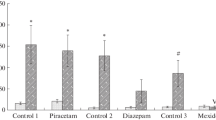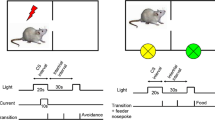Abstract
Rats were submitted to a training and a test session of shuttle avoidance. Exposure to a session of extinction of this task either 2 or 24 h after training interfered with retention test performance. Exposure to an open field 2, but not 24 h after the avoidance training also interfered with retention. Diazepam blocked the deleterious effect of extinction and of the open field on retention of the avoidance task. Diazepam alone had no effect when given after avoidance training; it did, however, also interfere with retention when given prior to training. It is likely, therefore, that diazepam cancelled the effect of the extinction or of the open field on avoidance retention because of anterograde amnesia (i.e., it prevented the recording of these tasks). The deleterious effect of the open field on retention of shuttle avoidance can be explained by retroactive interference caused by the addition of information. It is not due to a direct influence on retrieval, it is not due to extinction, and it had to be recorded 2 h after training in order to the effective.
Similar content being viewed by others
References
Cahill L, Brioni J, Izquierdo I (1986) Retrograde memory enhancement by diazepam: its relation to anterograde amnesia, and some clinical implications. Psychopharmacology 90:554–556
Ghoneim MM, Hinrichs JV, Mewaldt SP (1984) Dose-response analysis of the behavioral effects of diazepam: I. Learning and memory. Psychopharmacology 82:291–295
Izquierdo I (1975) A pharmacological separation of buzzer-shock pairing and of the shuttle-shock contingency as factors in the elicitation of shuttle responses to a buzzer in rats. Behav Biol 18:75–87
Izquierdo I (1986) Memory consolidation: not a useful hypothesis in the search for memory enhancing drugs. TIPS 12:476–477
Izquierdo I (1987) Consolidation redefined. In: ML Brandao (ed) Neurosciences and behavior. University Vitoria Press, Vitoria (in press)
Lister RG (1985) The amnesic action of benzodiazepines in man. Neurosci Biobehav Rev 9:87–94
Loftus E, Palmer JC (1974) Reconstruction of automobile destruction: An example of the interaction between language and memory. J Verb Learn Verb Behav 13:585–589
Netto CA, Dias RD, Izquierdo I (1985) Interaction between consecutive learnings: inhibitory avoidance and habituation. Behav Neural Biol 44:515–520
Riccio DC, and Richardson R (1984) The status of memory following experimentally induced amnesias: gone, but not forgotten. Physiol Psychol 12:59–72
Thiebot MH (1985) Some evidence for amnesic-like effects of benzodiazepines in animals. Neurosci Biobehav Rev 9:95–100
Author information
Authors and Affiliations
Rights and permissions
About this article
Cite this article
Pereira, M.E., Dalmaz, C., Rosat, R.M. et al. Diazepam blocks the interfering effect of post-training behavioral manipulations on retention of a shuttle avoidance task. Psychopharmacology 94, 402–404 (1988). https://doi.org/10.1007/BF00174697
Received:
Revised:
Issue Date:
DOI: https://doi.org/10.1007/BF00174697




